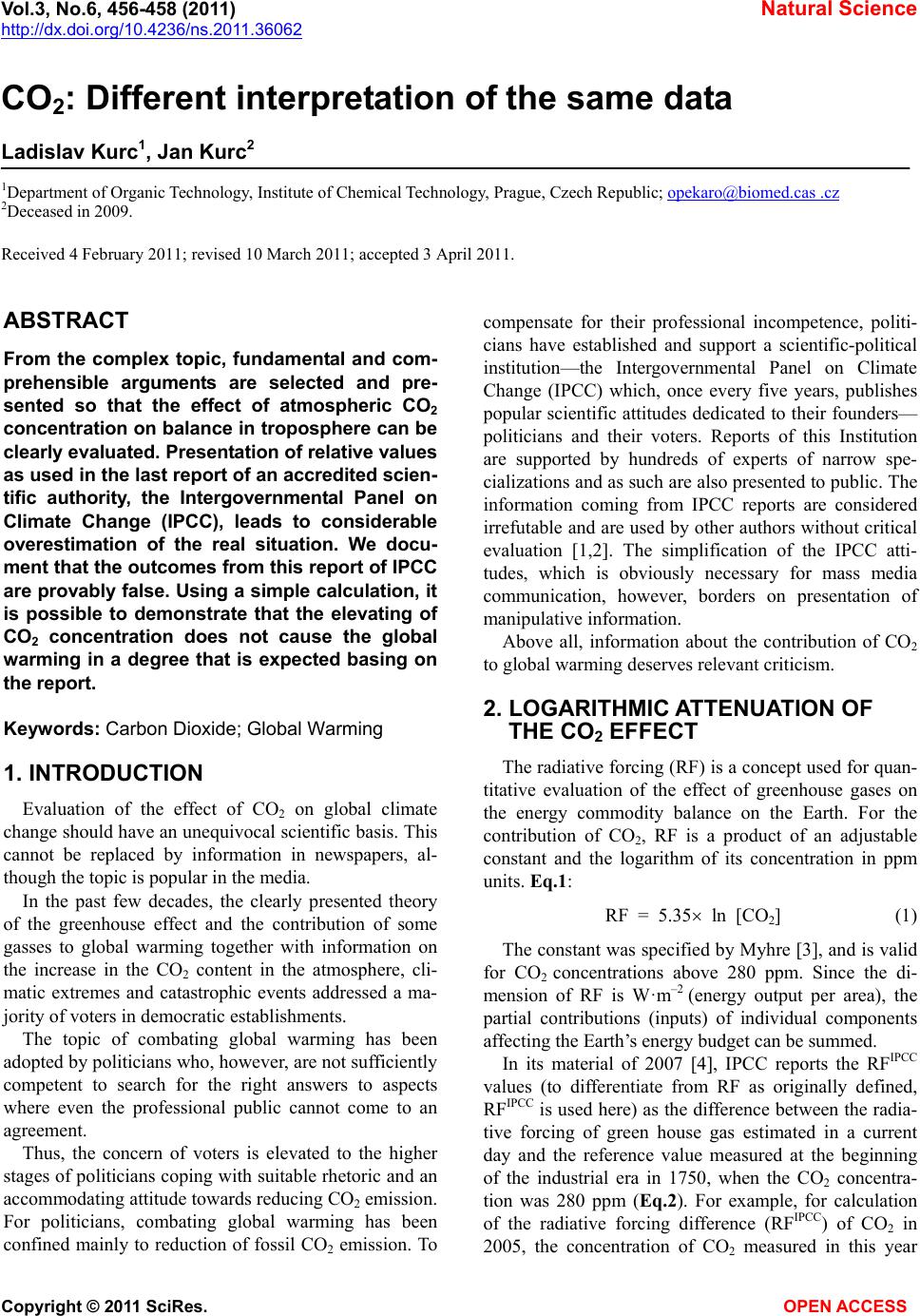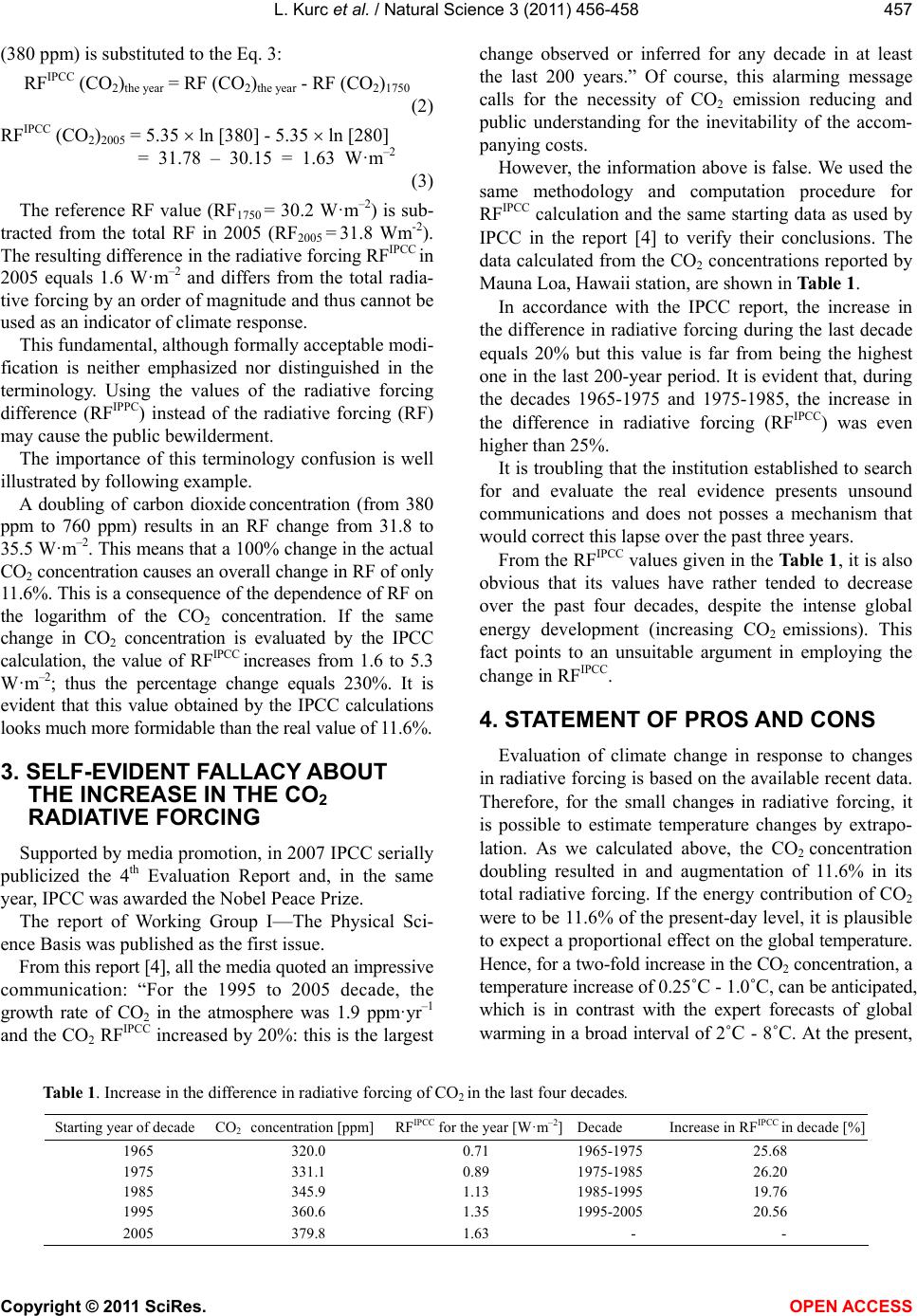Paper Menu >>
Journal Menu >>
 Vol.3, No.6, 456-458 (2011) Natural Science http://dx.doi.org/10.4236/ns.2011.36062 Copyright © 2011 SciRes. OPEN ACCESS CO2: Different interpretation of the same data Ladislav Kurc1, Jan Kurc2 1Department of Organic Technology, Institute of Chemical Technology, Prague, Czech Republic; opekaro@biomed.cas .cz 2Deceased in 2009. Received 4 February 2011; revised 10 March 2011; accepted 3 April 2011. ABSTRACT From the complex topic, fundamental and com- prehensible arguments are selected and pre- sented so that the effect of atmospheric CO2 concentration on balance in troposphere can be clearly evaluated. Presentation of relative values as used in the last report of an accredited scien- tific authority, the Intergovernmental Panel on Climate Change (IPCC), leads to considerable overestimation of the real situation. We docu- ment that the outcomes from this report of IPCC are provably false. Using a simple calculation, it is possible to demonstrate that the elevating of CO2 concentration does not cause the global warming in a degree that is expected basing on the report. Keywords: Carbon Dioxide; Global Warming 1. INTRODUCTION Evaluation of the effect of CO2 on global climate change should have an unequivocal scientific basis. This cannot be replaced by information in newspapers, al- though the topic is popular in the media. In the past few decades, the clearly presented theory of the greenhouse effect and the contribution of some gasses to global warming together with information on the increase in the CO2 content in the atmosphere, cli- matic extremes and catastrophic events addressed a ma- jority of voters in democratic establishments. The topic of combating global warming has been adopted by politicians who, however, are not sufficiently competent to search for the right answers to aspects where even the professional public cannot come to an agreement. Thus, the concern of voters is elevated to the higher stages of politicians coping with suitable rhetoric and an accommodating attitude towards reducing CO2 emission. For politicians, combating global warming has been confined mainly to reduction of fossil CO2 emission. To compensate for their professional incompetence, politi- cians have established and support a scientific-political institution—the Intergovernmental Panel on Climate Change (IPCC) which, once every five years, publishes popular scientific attitudes dedicated to their founders— politicians and their voters. Reports of this Institution are supported by hundreds of experts of narrow spe- cializations and as such are also presented to public. The information coming from IPCC reports are considered irrefutable and are used by other authors without critical evaluation [1,2]. The simplification of the IPCC atti- tudes, which is obviously necessary for mass media communication, however, borders on presentation of manipulative information. Above all, information about the contribution of CO2 to global warming deserves relevant criticism. 2. LOGARITHMIC ATTENUATION OF THE CO2 EFFECT The radiative forcing (RF) is a concept used for quan- titative evaluation of the effect of greenhouse gases on the energy commodity balance on the Earth. For the contribution of CO2, RF is a product of an adjustable constant and the logarithm of its concentration in ppm units. Eq.1: RF = 5.35 ln [CO2] (1) The constant was specified by Myhre [3], and is valid for CO2 concentrations above 280 ppm. Since the di- mension of RF is W·m–2 (energy output per area), the partial contributions (inputs) of individual components affecting the Earth’s energy budget can be summed. In its material of 2007 [4], IPCC reports the RFIPCC values (to differentiate from RF as originally defined, RFIPCC is used here) as the difference between the radia- tive forcing of green house gas estimated in a current day and the reference value measured at the beginning of the industrial era in 1750, when the CO2 concentra- tion was 280 ppm (Eq.2). For example, for calculation of the radiative forcing difference (RFIPCC) of CO2 in 2005, the concentration of CO2 measured in this year  L. Kurc et al. / Natural Science 3 (2011) 456-458 Copyright © 2011 SciRes. OPEN ACCESS 457 (380 ppm) is substituted to the Eq. 3: RFIPCC (CO2)the year = RF (CO2)the year - RF (CO2)1750 (2) RFIPCC (CO2)2005 = 5.35 ln [380] - 5.35 ln [280] = 31.78 – 30.15 = 1.63 W·m–2 (3) The reference RF value (RF1750 = 30.2 W·m–2) is sub- tracted from the total RF in 2005 (RF2005 = 31.8 Wm-2). The resulting difference in the radiative forcing RFIPCC in 2005 equals 1.6 W·m–2 and differs from the total radia- tive forcing by an order of magnitude and thus cannot be used as an indicator of climate response. This fundamental, although formally acceptable modi- fication is neither emphasized nor distinguished in the terminology. Using the values of the radiative forcing difference (RFIPPC) instead of the radiative forcing (RF) may cause the public bewilderment. The importance of this terminology confusion is well illustrated by following example. A doubling of carbon dioxide concentration (from 380 ppm to 760 ppm) results in an RF change from 31.8 to 35.5 W·m–2. This means that a 100% change in the actual CO2 concentration causes an overall change in RF of only 11.6%. This is a consequence of the dependence of RF on the logarithm of the CO2 concentration. If the same change in CO2 concentration is evaluated by the IPCC calculation, the value of RFIPCC increases from 1.6 to 5.3 W·m–2; thus the percentage change equals 230%. It is evident that this value obtained by the IPCC calculations looks much more formidable than the real value of 11.6%. 3. SELF-EVIDENT FALLACY ABOUT THE INCREASE IN THE CO2 RADIATIVE FORCING Supported by media promotion, in 2007 IPCC serially publicized the 4th Evaluation Report and, in the same year, IPCC was awarded the Nobel Peace Prize. The report of Working Group I—The Physical Sci- ence Basis was published as the first issue. From this report [4], all the media quoted an impressive communication: “For the 1995 to 2005 decade, the growth rate of CO2 in the atmosphere was 1.9 ppm·yr–1 and the CO2 RFIPCC increased by 20%: this is the largest change observed or inferred for any decade in at least the last 200 years.” Of course, this alarming message calls for the necessity of CO2 emission reducing and public understanding for the inevitability of the accom- panying costs. However, the information above is false. We used the same methodology and computation procedure for RFIPCC calculation and the same starting data as used by IPCC in the report [4] to verify their conclusions. The data calculated from the CO2 concentrations reported by Mauna Loa, Hawaii station, are shown in Table 1. In accordance with the IPCC report, the increase in the difference in radiative forcing during the last decade equals 20% but this value is far from being the highest one in the last 200-year period. It is evident that, during the decades 1965-1975 and 1975-1985, the increase in the difference in radiative forcing (RFIPCC) was even higher than 25%. It is troubling that the institution established to search for and evaluate the real evidence presents unsound communications and does not posses a mechanism that would correct this lapse over the past three years. From the RFIPCC values given in the Table 1, it is also obvious that its values have rather tended to decrease over the past four decades, despite the intense global energy development (increasing CO2 emissions). This fact points to an unsuitable argument in employing the change in RFIPCC. 4. STATEMENT OF PROS AND CONS Evaluation of climate change in response to changes in radiative forcing is based on the available recent data. Therefore, for the small changes in radiative forcing, it is possible to estimate temperature changes by extrapo- lation. As we calculated above, the CO2 concentration doubling resulted in and augmentation of 11.6% in its total radiative forcing. If the energy contribution of CO2 were to be 11.6% of the present-day level, it is plausible to expect a proportional effect on the global temperature. Hence, for a two-fold increase in the CO2 concentration, a temperature increase of 0.25˚C - 1.0˚C, can be anticipated, which is in contrast with the expert forecasts of global warming in a broad interval of 2˚C - 8˚C. At the present, Table 1. Increase in the difference in radiative forcing of CO2 in the last four decades. Starting year of decade CO2 concentration [ppm]RFIPCC for the year [W·m–2]Decade Increase in RFIPCC in decade [%] 1965 320.0 0.71 1965-1975 25.68 1975 331.1 0.89 1975-1985 26.20 1985 345.9 1.13 1985-1995 19.76 1995 360.6 1.35 1995-2005 20.56 2005 379.8 1.63 - -  L. Kurc et al. / Natural Science 3 (2011) 456-458 Copyright © 2011 SciRes. OPEN ACCESS 458 rate of combustion of fossil carbon fuels and concentra- tion of CO2 an increase of 1.9 ppm·yr–1, this situation could occur after 200 years. From the presumptive extend of climate susceptibility to changes in radiative forcing estimated by IPCC [5] it follows that a doubling of CO2 concentration enhances the average global temperature by about 3 degrees of Celsius. This would mean that climate sensitivity equals to 0.8 degree of Celsius per one RF unit (W/m2). This allegation is accepted in prestigious scientific publica- tions [1,2] as a proven fact. It should be considered, however, that on doubling of the CO2 concentration, the contemporaneous RF (CO2) value increases from 100% to 111.6 %. If the climate sensitivity presented by IPCC were correct, then a simple energy balance would show that the green house effect (100%, currently) increases the global temperature by 26 degrees of Celsius, which is far beyond generally accepted range of 2-8 Celsius degree. This is a crucial discrepancy, which should lead to a correction of climate sensitivity and hence to cor- rection of projections of future changes in climate. 5. CONCLUSIONS The data presented above lead to a number of ques- tions. For some of them, like “is Myhre’s model [3] of RF dependence on the CO2 concentration correct?” the answer is simple. Yes. The logarithmic character of the dependence originates from a law of nature. Some ques- tions cannot be answered: Are the costs spent for reduc- tion of CO2 emissions to prevent the slight climate warming appropriate? This question has to be addressed by voters and their politicians. Environmental business consumes huge resources. An evidently purposeless part of them could have been used to combat, e.g., malignant tumors, which now represent much greater menace for mankind than global warming 6. ACKNOWLEDGEMENTS This article was supported by the Czech National Agency for Agri- cultural Research, project No, QH91303. REFERENCES [1] Kiehl, J. (2011) Lessons from Earth’s past. Science, 331, 158-159. [2] Solomon, S.D., Rosenlof, K.H., Portmann, R.W., Daniel, J.S., Davis, S.M., Sanford, T.J. and Plattner, G.K. (2010) Contributions of stratospheric water vapor to decadal changes in the rate of global warming. Science, 327, 1219-1223. [3] Myhre, G., Highwood, E.J., Shine, K.P. and Stordal, F. (1998) New estimates of radiative forcing due to well mixed greenhouse gases. Geophysical Research Letters, 25, 2715-2718. [4] Forster, P., Ramasway, V., Artaxo, P., Berntsen, T., Betts, R., Fahey, D.W., Haywood, J., Lean, J., Lowe, D.C., Myhre, G., Nganga, J., Prinn, R., Raga, G., Schulz, M. and Dorlando Van, R. (2007) Changes in atmospheric constituents and in radiative forcing. In: Solomon, S.D., Qin, D., Manning, M., Chen, Z., Marquist,M., Averyt, K.B., Tignor, M. and Miller, H.L., Eds., Climate Change 2007: The Physical Science Basic. Contribution of Working Group I IPCC, Cambridge, New York, 131-140. [5] Mehl, G.A., Stocker, T.F., Collins, W.D., Friedlingstein, P., Gaye, A.T., Gregory, J.M., Kitoh, A., Knutti, R., Murphy, J.M., Noda, A., Raper, S.C.B., Watterson, I.G., Weaver, A.J. and Zhao, Z.-C. (2007) Global climate pro- jection. In: Solomon, S.D., Qin, D., Manning, M., Chen, Z., Marquist, M., Averyt, K.B., Tignor, M. and Miller, H.L., Ed., Climate Change 2007: The Physical Science Basic. Contribution of Working Group I IPCC, Cam- bridge, New York, 797. |

